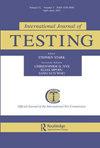运用比较判断和Rasch模型研究考试难度的可比性
IF 1.4
Q2 SOCIAL SCIENCES, INTERDISCIPLINARY
引用次数: 3
摘要
采用专家配对比较和学生测试的方法,研究了英国16岁学生数学试题中6个题目的期望难度和实际难度之间的关系。Rasch模型的一种变体应用于比较数据,以建立预期难度的尺度。在测试中,2933名学生采用了等效组设计,允许将项目的实际难度放在同一测量尺度上。结果表明,采用比较判断法得出的期望难度与根据测试数据得出的实际难度具有较强的相关性。这表明比较判断可能是考察考试难度可比性的有效方法。在由于安全或其他风险原因而无法进行预测试的情况下,该方法可能被用作高风险测试预测试的替代方法。本文章由计算机程序翻译,如有差异,请以英文原文为准。
Investigating the Comparability of Examination Difficulty Using Comparative Judgement and Rasch Modelling
The relationship of expected and actual difficulty of items on six mathematics question papers designed for 16-year olds in England was investigated through paired comparison using experts and testing with students. A variant of the Rasch model was applied to the comparison data to establish a scale of expected difficulty. In testing, the papers were taken by 2933 students using an equivalent-groups design, allowing the actual difficulty of the items to be placed on the same measurement scale. It was found that the expected difficulty derived using the comparative judgement approach and the actual difficulty derived from the test data was reasonably strongly correlated. This suggests that comparative judgement may be an effective way to investigate the comparability of difficulty of examinations. The approach could potentially be used as a proxy for pretesting high-stakes tests in situations where pretesting is not feasible due to reasons of security or other risks.
求助全文
通过发布文献求助,成功后即可免费获取论文全文。
去求助
来源期刊

International Journal of Testing
SOCIAL SCIENCES, INTERDISCIPLINARY-
CiteScore
3.60
自引率
11.80%
发文量
13
 求助内容:
求助内容: 应助结果提醒方式:
应助结果提醒方式:


